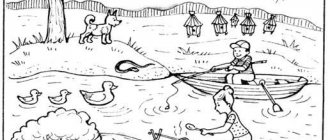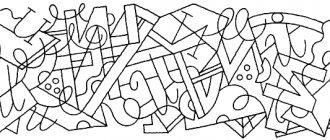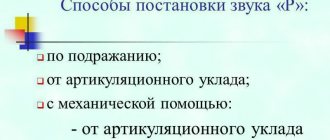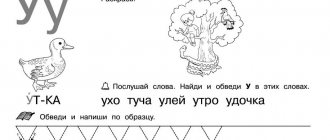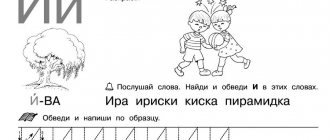Lesson notes for the preparatory group of kindergarten
With the transition of primary school to three-year education, the issue of preparing preschool children for school became acute. Teachers working in preschool institutions, and especially parents, often tend to solve this issue by “training” 6-year-old children according to the first grade program. Unfortunately, it quickly becomes clear that this way of preparing a child for school is not effective: as soon as the supply of “school” knowledge runs out, he begins to lag behind his classmates. This is explained by the fact that the modern primary school curriculum requires special attention to the development of learning skills in children. Is it possible to limit preparation for school to the last year of preschool childhood? Of course not! If the system of education and training of preschoolers in kindergarten should be subordinated to the ultimate goal - preparation for learning at school, then it is also necessary to talk about the specifics of education not only in preparatory school, but also in the senior group of kindergarten, i.e. about the specifics mental education of children in the second half of preschool childhood. L. S. Vygotsky pointed out that there is a need for “a sharp differentiation of learning in the second stage of preschool age in comparison with the first stage of preschool age.” Only this approach can make the mental education of preschool children truly effective. Research conducted at the Research Institute of Preschool Education of the Academy of Pedagogical Sciences of the USSR under the leadership of N. N. Poddyakov shows that “the most significant changes in the mental development of a child are the result of the assimilation not of any individual knowledge and skills, but ... of a certain system of knowledge, reflecting essential connections and depending on one or another area of reality.” In order to rebuild the system of mental education of preschool children in this way, it is necessary to find forms of presenting knowledge that correspond to the age capabilities of children. This work is devoted to one of the issues of mental education of preschoolers - teaching literacy on the basis of theoretical principles developed by P. Ya. Galperin, A. V. Zaporozhets, D. B. Elkonin. The proposed literacy course takes into account the age capabilities of older preschoolers and is built on introducing children to the sound reality of language. Developing in children the appropriate means and skills for isolating and comparing units of linguistic reality is an indispensable condition for literacy. We believe that it is advisable to begin preparing children for school not in preparatory school, but in the senior group of kindergarten. In doing so, we rely on the data of Soviet psychologists, which testify to the special “feeling” of a 4-5-year-old child for language. At an older age, this linguistic sense weakens somewhat; the child, as D.N. Bogoyavlensky says, seems to lose his “linguistic abilities.” Introducing a child into linguistic reality at the moment of the most acute “linguistic sense” is the most effective means for mastering this reality. Can a 4-5 year old child act with the form of a word, is this level of abstraction possible for him? If we rely in teaching on the child’s already developed characteristics of mental activity, then there can be only one answer to this question: of course, it is too difficult. However, as L. S. Vygotsky notes, the development of a child is determined not only by the already mature traits of his personality, but also by those mental processes that are in the maturation stage. “Research shows,” writes L. S. Vygotsky, “that for all processes of upbringing and education, the most significant are precisely these processes, which are in the stage of maturation and have not yet matured at the time of learning.” In order to translate the ability for formal, rather abstract activity with words into the real mental abilities of a child, it is necessary to structure the learning process itself in a special way. The book contains notes on the lessons developed for the entire course of study, including not only educational material, but also a detailed description of the work of the teacher and the methods of children's activities in the classroom. The basis of the proposed experimental program is the method of teaching elementary reading developed by D. B. Elkonin, supplemented by a large number of different word games that make up the main part of the classes and necessarily contain an educational task. Training under the experimental program was carried out since 1965 in kindergarten No. 144 and since 1967 in kindergarten No. 1914 in Moscow. Since 1969, 13 kindergartens in Moscow have been operating under this program.
More than a hundred years ago, K. D. Ushinsky’s book “Native Word” was published, which opened a new era in teaching children to read and write. The word “era” is not an exaggeration, because the issues of methods of teaching literacy were and are still very acute today, since reading has always been considered as the first and main subject of primary education. The sound method, proposed by K. D. Ushinsky in 1864, replaced the pre-existing letter-subjunctive method. The method developed by K. D. Ushinsky is fundamentally different from all previous methods in that it introduces children to the sounds of speech not as some abstract sounds, but by isolating them directly from speech. K. D. Ushinsky spoke about it this way: “I do not prefer the sound method because children learn to read and write more quickly with it; but because, while successfully achieving its special goal, this technique at the same time gives independence to the child, constantly exercises his attention, memory and reason of the child, and when the book is then opened in front of him, he is already significantly prepared to understand what he is reading , and, most importantly, his interest in learning is not suppressed, but rather aroused.” How does K. D. Ushinsky solve the problem of teaching reading? First of all, learning to read for him is part of teaching his native language, which includes: 1) visual learning; 2) preparatory exercises in writing; 3) sound exercises that prepare for reading. Since in this work we are only interested in teaching reading, we will analyze only the third group of these activities. According to the method of K.D. Ushinsky, children first become familiar with the sounds a, o, i. As soon as the children, following the teacher, learn to correctly name these sounds (in isolation), the teacher pronounces a whole word that contains one of these sounds and asks the children to determine what sound they know is in this word. "Teacher. What sounds do you know? First? Second? Third? But I’ll tell you the whole word - ox! What sound is there - a or o? Ox! The most capable students will guess right the first time. If no one guesses, then the teacher must say himself. After the third and fourth word, everyone will begin to guess, but at first, of course, not without mistakes.” For these exercises, monosyllabic words are taken with the desired vowel in the middle of the word. Note that the study of each sound is immediately accompanied by the display of a letter, i.e., the sound is always introduced along with the letter. Thus, children learn the sounds a, o, i, e, u, s. Then they move on to highlighting vowels in two-syllable and polysyllabic words, reinforcing already learned sounds and letters and becoming familiar with the letters i, yu, e. Only after children have mastered all the vowels does familiarity with consonants begin, and K. D. Ushinsky believes that “to understand for children the meaning of a consonant letter is the most important and most difficult thing in all of teaching literacy. This is the key to reading: once children have mastered it, everything else will come easily.” Consonants are introduced by comparing two words with each other that differ from each other by one consonant: mustache - uzh. Then, just as before, the children looked for familiar vowels in the words called by the teacher, they begin to look for the studied consonants. The next stage is the transition from learning sounds to reading. Introducing each new consonant begins by showing a picture with the word written underneath it. Children first name the word from the picture, then conduct a sound analysis of this word (three-sound words: wasps, spruce, willow, etc.); find familiar sounds, name the first and last sounds of the word, reach a new sound, become familiar with the letter that represents it, and then read the word. This method has the following advantages: 1) during training, intensive work is carried out aimed at the mental education of the child; 2) children work with whole sounding words, and not with isolated sounds. It is important that children are gradually led from isolating a single sound in a word to conducting a complete sound analysis of the word. These are the unconditional and extremely significant advantages of this method. Having analyzed the process of teaching elementary reading, we find that children trained using this method never read unfamiliar words. Before reading a word, children conduct a detailed and complete sound analysis of it, write down this word and only after that read it, i.e., while reading, they know in advance which word they are reading! Naturally, children do not experience any pain in merging sounds; they pronounce a word they know in advance. Having paid great attention to introducing children to the sound side of speech and sound analysis, K. D. Ushinsky did not provide a way to teach the reading process itself. Children who learned in this way had to intuitively discover the principle of reading themselves. Over the past years, the sound method has repeatedly been subjected to various kinds of modifications, the harmful consequence of which was the emerging idea of reading as a process of stringing together “pure” sounds with the sequential perception of letters. If the essence of K. D. Ushinsky’s method was that he placed the main emphasis in teaching reading on serious, long-term work with the sound side of the language and therefore called his method sound, then later the name “sound” began to mean that when reading they were supposedly called “pure” sounds, the fusion of which led to reading. This understanding of the sound method was sharply criticized by I. N. Shaposhnikov, who returned to the sound method the accents lost since the time of K. D. Ushinsky, even strengthening them in his theoretical developments. According to I. N. Shaposhnikov, only those who hear them in speech know how to merge sounds. The ability to recognize and hear the sounds of speech lies the whole “mystery”, the whole “secret” of reading. When learning to read using the method of I. N. Shaposhnikov, children divide each word into syllables, and syllables into sounds. Each highlighted sound is designated by a letter (in order to avoid graphic difficulties, I. N. Shaposhnikov suggests using a printed font). Thus, the child does not simply divide the word into sounds, but immediately expresses it in letters: he writes, completing the process of abstracting sounds in the process of writing. Each written word is then read twice by the children. (I.N. Shaposhnikov is against giving children words that they do not know how to write correctly.) Such reading, in his opinion, speeds up the process of sound abstraction: after some time, the student establishes a connection between letters and sounds and begins to read. Children move on to reading an unfamiliar text only when almost the entire alphabet has been covered in this way, i.e., before starting to read an unfamiliar text (not analyzed or written down before reading), children practice reading for a long time following fresh traces of analysis, reading in this way almost all possible simple syllables. So, according to the method of I. N. Shaposhnikov, as well as according to the method of K. D. Ushinsky, children learn to read, starting from sound reality. We see that for the best teachers working using the sound method, the moment of merging sounds into a syllable is completely excluded from the learning process, since children spend a long time practicing “reading” syllables and words known in advance. However, it must be admitted that such a solution, although certainly interesting and extremely facilitating for children to learn to read, does not reveal to us the mechanism of the reading process itself. The methodological manuals used by teachers today still recommend the technique of merging sounds, the technique of “pure” pronunciation of a consonant when reading an open syllable. For reading, children are first offered words only with hard consonants, since, according to methodologists, reading words with soft consonants is much more difficult than with hard ones. And indeed, with the currently existing method of teaching reading by stringing together “pure” sounds, it is difficult to even imagine how one can ask a child to read a syllable with a soft consonant: after all, in the syllable mya, for example, the child should call the first sound m. Let us recall that K. D. Ushinsky suggested introducing children first to all vowel letters and immediately moving on to reading syllables with both hard and soft consonants. Although no one denies the importance and obligation of teaching children sound analysis, in fact, this sound analysis is only vaguely reminiscent of the one proposed a hundred years ago by K. D. Ushinsky. Currently, it is necessary to develop a new methodology for teaching reading. Research in this direction was started more than ten years ago by D. B. Elkonin.
| Due to its large volume, this material is placed on several pages: 1 |

